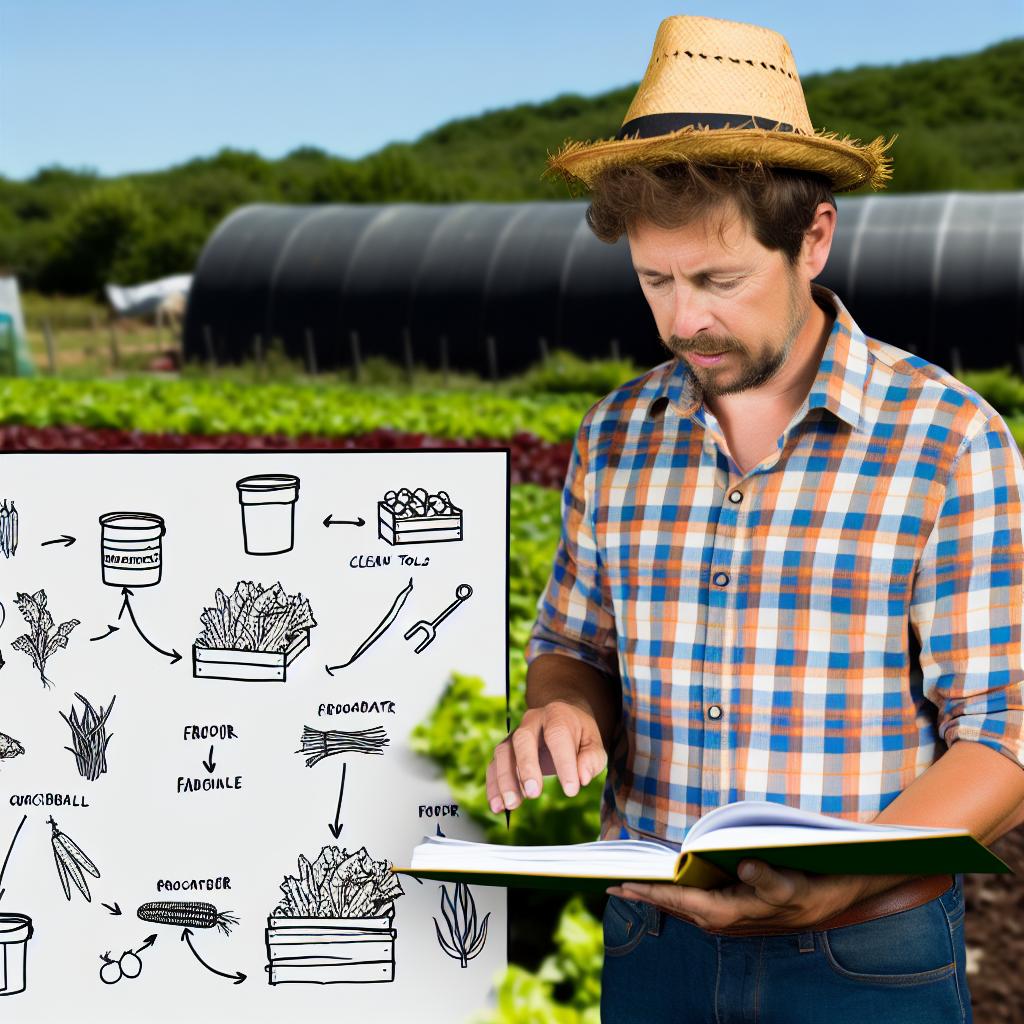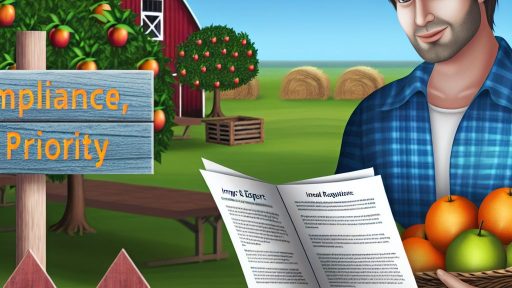Overview of Food Safety Standards in Agriculture
Importance of Food Safety
Food safety plays a critical role in public health.
It helps prevent foodborne illnesses and ensures consumer trust.
Moreover, adhering to safety standards protects producers from legal issues.
Key Food Safety Standards
Various food safety standards guide agricultural practices.
The FDA provides regulations for food safety in the U.S.
Additionally, the USDA sets forth guidelines for meat, poultry, and egg products.
Moreover, Global Food Safety Initiative (GFSI) standards promote uniformity worldwide.
Implementing Food Safety Standards
Farm operations must adopt several practices to ensure compliance.
First, they should train employees on hygiene and safety procedures.
Next, regular audits can identify areas needing improvement.
Additionally, farms must keep accurate records of production and safety protocols.
Benefits of Compliance
Implementing food safety standards enhances product quality.
It also opens markets and increases sales potential.
Moreover, consumers gain confidence in food products, leading to loyalty.
Challenges Faced by Farmers
Farmers can encounter various challenges when meeting safety standards.
Transform Your Agribusiness
Unlock your farm's potential with expert advice tailored to your needs. Get actionable steps that drive real results.
Get StartedLimited resources may hinder compliance efforts.
Additionally, maintaining consistent training can be demanding.
Furthermore, regulatory changes can create confusion for producers.
Future Directions for Food Safety in Agriculture
As food safety standards evolve, farmers must stay informed.
Continuous education and adaptation will ensure compliance.
Ultimately, integrating food safety standards can lead to a sustainable future for agriculture.
Importance of Food Safety in Farm Operations
Protection of Public Health
Food safety directly impacts public health.
Implementing safety standards reduces the risk of foodborne illnesses.
Farmers play a key role in ensuring safe food products.
This responsibility extends from planting to harvesting.
Compliance with Regulations
Food safety regulations are mandatory in agriculture.
Compliance protects both consumers and producers.
It also helps avoid costly legal issues.
Adhering to these standards fosters trust among consumers.
Enhancing Market Opportunities
Implementing food safety measures opens new market opportunities.
Retailers and distributors often require compliance with safety standards.
This can lead to increased sales and customer base.
In addition, certified farms can command higher prices.
Support for Sustainable Practices
Food safety is linked to sustainable farming practices.
It promotes responsible use of resources like water and soil.
Adopting safety measures can enhance overall farm efficiency.
Ultimately, this leads to a healthier ecosystem.
Building Consumer Confidence
Consumers are more likely to trust farms that adhere to safety standards.
Transparency in production processes fosters confidence.
Showcase Your Farming Business
Publish your professional farming services profile on our blog for a one-time fee of $200 and reach a dedicated audience of farmers and agribusiness owners.
Publish Your ProfileMoreover, consumers are increasingly concerned about their health.
Providing safe products helps meet these concerns directly.
Key Food Safety Standards to Implement on Farms
Understanding the Importance of Food Safety
Food safety plays a critical role in agricultural operations.
It protects consumers from foodborne illnesses.
Moreover, it enhances the reputation of farms.
Implementing food safety standards is necessary for compliance.
Farmers gain consumer trust through high safety standards.
Good Agricultural Practices (GAP)
Good Agricultural Practices ensure the safety of produce.
GAP focuses on minimizing contamination risks during production.
It covers soil management, water quality, and pest control.
Farmers must train staff on these practices.
Furthermore, regular audits help maintain compliance.
Hazard Analysis Critical Control Point (HACCP)
HACCP identifies potential food safety hazards.
It outlines crucial control points in the production process.
Farmers should establish monitoring procedures for each control point.
This systematic approach prevents food safety issues.
Additionally, obtaining HACCP certification can enhance marketability.
Traceability Systems
Implementing traceability is essential for risk management.
Traceability allows tracking products from farm to table.
This process helps quickly address food safety concerns.
Farmers should integrate record-keeping systems for tracking.
Incorporating technology can streamline this process significantly.
Employee Training and Engagement
Training employees on food safety standards is crucial.
Engaged workers help maintain high safety levels.
Regular workshops keep staff updated on best practices.
This fosters a culture of safety within the organization.
Incentivizing safety practices can enhance employee participation.
Regular Inspections and Compliance Checks
Regular inspections help identify safety lapses.
Farmers must conduct self-assessments routinely.
Using checklists can simplify this process.
Regular compliance checks prepare farms for external audits.
Finally, resolving issues promptly ensures ongoing safety.
Delve into the Subject: Climate Laws and Their Effects on Farming Operations
Training Employees on Food Safety Practices
Importance of Training
Training employees is crucial for effective food safety practices.
It ensures all staff understand their roles in maintaining safety standards.
Moreover, proper training helps reduce foodborne illnesses.
When employees are knowledgeable, they can better prevent contamination.
Developing a Training Program
A comprehensive training program is essential for farm operations.
Begin by assessing the specific needs of your operation.
Then, establish clear training objectives and goals.
Showcase Your Farming Business
Publish your professional farming services profile on our blog for a one-time fee of $200 and reach a dedicated audience of farmers and agribusiness owners.
Publish Your ProfileConsider including the following in your curriculum:
- Food handling and storage techniques.
- Sanitation and hygiene practices.
- Identification of hazards and risk factors.
- Emergency response protocols.
Methods of Delivery
Using diverse training methods can enhance employee engagement.
Consider incorporating workshops, online courses, or hands-on sessions.
Utilize visual aids to reinforce important concepts.
Regular refreshers will keep the information fresh in employees’ minds.
Monitoring and Evaluation
Monitoring the effectiveness of training is vital for success.
Implement assessments to gauge employee understanding.
Conduct evaluations after training sessions to gather feedback.
Adjust the training program based on employee performance and feedback.
Creating a Culture of Food Safety
Fostering a culture of food safety is key to long-term success.
Encourage open communication about safety concerns.
Recognize and reward employees who demonstrate best practices.
Provide ongoing support to reinforce food safety standards.
See Related Content: Legal Implications Of Pesticide Misuse In Farming
Monitoring and Record-Keeping for Compliance
Importance of Monitoring
Monitoring is crucial for maintaining food safety standards on farms.
It helps identify potential hazards before they become critical issues.
Furthermore, it promotes accountability in farming practices.
Implementing Effective Record-Keeping
Effective record-keeping supports compliance with regulations.
Farmers should document all processes from planting to harvest.
This documentation should include pesticide applications and food handling procedures.
Additionally, records of equipment sanitation must be maintained.
Benefits of Consistent Record-Keeping
Consistent record-keeping enhances traceability in case of foodborne illness outbreaks.
It also simplifies audits by regulatory bodies.
Farmers can make informed decisions based on historical data insights.
Utilizing Technology for Monitoring
Technology plays a vital role in modern farm management.
Farmers can use software to track compliance and monitor processes.
Mobile applications can facilitate real-time data entry and retrieval.
Furthermore, sensors can provide accurate environmental data.
Choosing the Right Tools
Selecting the right tools is essential for effective monitoring.
Farmers should evaluate different software solutions based on their needs.
Additionally, training staff on these tools improves their effectiveness.
Regular Reviews and Updates
Regular reviews of monitoring processes ensure compliance with current standards.
Farmers should adjust their practices based on recent regulations.
Updates to record-keeping systems can enhance efficiency and accuracy.
Engaging External Auditors
Engaging external auditors can provide an objective review of operations.
They can identify gaps in compliance that internal teams might overlook.
This practice fosters a culture of continuous improvement on the farm.
You Might Also Like: Funding Opportunities Through Conservation Programs

Integrating Technology for Enhanced Food Safety
Implementing Digital Traceability Systems
Digital traceability systems improve the transparency of farm operations.
These systems allow farmers to track products from field to table.
Showcase Your Farming Business
Publish your professional farming services profile on our blog for a one-time fee of $200 and reach a dedicated audience of farmers and agribusiness owners.
Publish Your ProfileSuch tracking helps identify contamination sources quickly.
Farmers can then take prompt actions to prevent further issues.
Moreover, traceability enhances consumer confidence in food safety.
Utilizing Data Analytics for Risk Management
Data analytics plays a vital role in managing food safety risks.
Farmers can analyze historical data to identify risk patterns.
By understanding these trends, they can implement preventive measures.
Additionally, predictive analytics can forecast potential hazards.
This proactive approach minimizes the chances of foodborne illnesses.
Adopting Automated Monitoring Technologies
Automated monitoring ensures consistent oversight of farm conditions.
Technologies such as IoT devices track environmental factors.
Farmers can monitor temperature, humidity, and soil moisture in real time.
These devices alert farmers to any abnormalities promptly.
As a result, timely interventions help maintain food safety standards.
Incorporating Training and Education via E-Learning
E-learning platforms provide essential training on food safety protocols.
Farmers and workers can access resources anytime, anywhere.
This accessibility ensures that all team members stay informed.
Regular training updates improve compliance with safety standards.
Ultimately, an educated workforce contributes to better food safety practices.
Gain More Insights: The Role Of Government Agencies In Pesticide Regulation
Challenges in Implementing Food Safety Standards on Farms
Understanding the Complex Regulations
Food safety standards vary significantly across regions and countries.
Farmers often struggle to stay updated with these complex regulations.
Moreover, inconsistent standards can create confusion and inefficiencies.
Consequently, understanding the local and federal guidelines is essential.
Financial Constraints
Implementing food safety standards often requires significant financial investment.
Many small farms operate on tight budgets, making compliance difficult.
Furthermore, the cost of training staff adds an additional burden.
Farmers may need to prioritize critical investments over compliance costs.
Lack of Knowledge and Training
Many farm workers lack sufficient knowledge about food safety protocols.
Without proper training, maintaining hygiene standards can be challenging.
Training programs need to be accessible and tailored to farm-specific needs.
Additionally, ongoing education is crucial to keep workers informed.
Resistance to Change
Farm operations often rely on long-standing practices and traditions.
Many farmers may be resistant to adopting new safety measures.
This reluctance can arise from a lack of understanding of the benefits.
Gradual integration of new practices may help ease this transition.
Logistical Challenges
Implementing food safety standards requires substantial changes in operations.
Farm layout and workflow often need re-evaluation for efficiency.
Logistical challenges can arise from the need for proper storage and transportation.
Moreover, frequent inspections can strain daily operations and resources.
Maintaining Traceability
Traceability is a key aspect of food safety and presents its own challenges.
Showcase Your Farming Business
Publish your professional farming services profile on our blog for a one-time fee of $200 and reach a dedicated audience of farmers and agribusiness owners.
Publish Your ProfileFarmers must track the origins of their products continuously.
Establishing an efficient tracking system can be complicated and time-consuming.
Failure to maintain traceability can lead to severe legal repercussions.
Case Studies: Successful Integration of Food Safety on Farms
Case Study: Green Valley Farms
Green Valley Farms implemented rigorous food safety protocols in 2021.
This initiative aimed to enhance the quality of their produce.
They established a dedicated food safety team responsible for training staff.
Regular workshops ensured everyone understood safety standards.
As a result, Green Valley Farms reported a 30% reduction in contamination incidents.
Case Study: Meadowbrook Orchards
Meadowbrook Orchards prioritized food safety by adopting organic practices.
They eliminated harmful pesticides and focused on natural solutions.
This shift attracted more customers concerned about health and safety.
The orchard’s sales increased significantly after the change.
Periodic audits helped maintain compliance with safety guidelines.
Case Study: Hillside Dairy Farm
Hillside Dairy Farm faced challenges with safety regulations in 2020.
To address this, they upgraded their milking technology.
New equipment minimized the risk of bacterial contamination.
They also implemented a rigorous cleaning protocol for all facilities.
Feedback from health inspectors showed noticeable improvements.
Key Lessons Learned
Investing in staff training is crucial for effective food safety management.
Regular audits help maintain compliance and improve practices.
Utilizing technology can enhance safety measures significantly.
Transparency with customers builds trust in food production processes.




